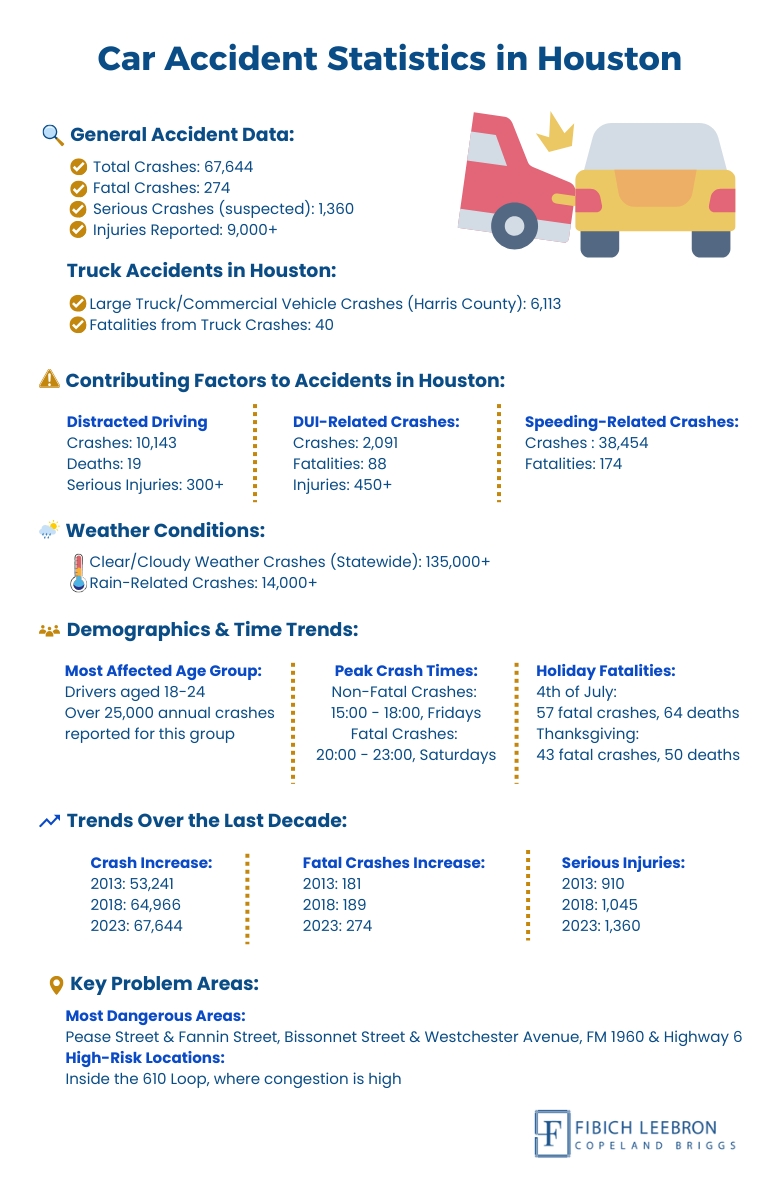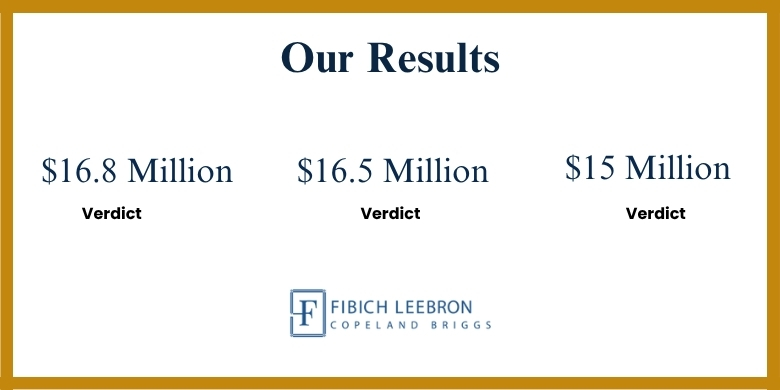Houston Car Accident Statistics: All You Should Know

Do you live or work in Houston, Texas? If so, you’re probably all too familiar with the dangers of driving, walking, or biking along local roads and highways. In particular, stretches of the Gulf Freeway, Westheimer Road, Post Oak Boulevard, Bissonnet Street, and Westchester Avenue are prone to crashes. Recent Houston car accident statistics show just how common serious injuries and traffic deaths have become across the city.
If you’ve been in a crash, you don’t have to deal with the aftermath alone. The Houston car accident lawyers at Fibich, Leebron, Copeland & Briggs have been handling local car accident cases for years. We have multiple decades of legal experience, so our team knows how to deal with insurance companies, gather the right evidence, and fight for the money you need. Contact our law firm now for a free consultation to learn how we can help you seek the recovery you deserve.
Houston’s Car Accident Problem
Houston has a serious car accident problem because of how the city is built and how people get around. As one of the largest and most populated cities in the country, Houston’s roads see heavy traffic every day. The city is spread over a wide area, so most people rely on cars to get everywhere. Houston is also a major transportation hub, with freight trucks, delivery vehicles, and commuters all sharing the roads at all hours. Long commutes, high speed limits, and limited public transit make Houston’s streets even more dangerous. These conditions put drivers, pedestrians, and cyclists at risk across the city.

Latest Car Accident Statistics in Houston
In 2023, Houston had 67,644 total crashes, including 274 fatal crashes and 1,360 suspected serious crashes, according to the Texas Department of Transportation. Police reported over 9,000 crash injuries in Houston that year.
A recent University of Houston study indicated that the city’s most dangerous areas include Pease Street and Fannin Street, Bissonnet Street and Westchester Avenue, and several intersections along FM 1960 and Highway 6. Many of the top crash spots also sit inside the 610 Loop, where traffic congestion is common.
Breakdown by Accident Type
Throughout Houston and the rest of the U.S., rear-end crashes are more common than any other type. There were 3.7 million rear-end crashes across the U.S. that caused about 3,300 deaths. There were also 380,000 head-on collisions nationwide, which resulted in approximately 5,800 deaths. Side-impact and sideswipe wrecks caused 1,600 deaths and more than 425,000 injuries.
In Texas, drivers struck 837 pedestrians in reported crashes. These crashes killed 205 people and seriously injured more than 240. There were also 187 total crashes involving cyclists statewide, and these accidents resulted in 35 deaths.
That year in Harris County, there were also 6,113 crashes involving large trucks or commercial vehicles. These accidents caused 40 deaths and injured hundreds more.
Contributing Factors to Car Accidents in Houston
Distracted driving contributed to 10,143 crashes in Harris County. These crashes killed 19 people and seriously hurt nearly 300 more.
Driving under the influence contributed to 2,091 crashes in Houston. These crashes killed 88 people and left more than 450 people with reported injuries.
Speeding played a role in 38,454 crashes in Harris County. These crashes contributed to 174 deaths and thousands of injuries.
The vast majority of crashes throughout Texas happened in clear or cloudy weather conditions (over 135,000), but rain was present at the time of more than 14,000 crashes. Weather conditions like snow and fog were less common contributing factors in accidents statewide.
Demographic Trends and Time-Based Stats
Drivers between the ages of 18 and 24 showed the highest crash totals in Texas. Each age group from 18 to 24 had over 25,000 drivers involved in reported crashes.
Crashes peaked during weekday rush hours throughout the year in Texas. The highest number of non-fatal crashes occurred between 3:00 PM and 6:00 PM, with the most overall occurring on Fridays. Fatal crashes spiked later in the evening, especially between 8:00 PM and 11:00 PM. Saturdays saw the most fatal crashes, followed by Sundays and Fridays.
Holidays led to sharp increases in deadly crashes. The Fourth of July had the highest number of fatalities and fatal crashes in Texas, with 57 fatal crashes and 64 deaths. Thanksgiving followed, with 43 fatal crashes and 50 deaths.
Car Accident Trends Over the Last Five to Ten Years in Houston
Crash numbers in Houston have increased notably over the last decade. In 2013, the city reported 53,241 total crashes. By 2018, that number had risen to 64,966, and by 2023, it had reached 67,644. Fatal crashes also increased. Houston saw 181 fatal crashes in 2013, 189 in 2018, and 274 in 2023. Serious injuries and minor crashes are more common, too. Houston had 910 serious crashes in 2013, 1,045 in 2018, and 1,360 in 2023.
These numbers show that crashes in Houston are trending upward, especially when it comes to deaths and serious injuries. Several factors could be contributing to these trends. For instance, more people now use rideshare services, which add more vehicles to busy roads. Autonomous vehicles are still rare, but as they grow more common, they could add new complications to Houston’s busy traffic environment. At the same time, road expansions in and around Houston might ease traffic congestion in some areas while increasing speed and crash risk in others.
Houston has received millions in federal grants in recent years for street safety projects tied to its Vision Zero plan. Vision Zero aims to eliminate traffic deaths by redesigning roads, improving sidewalks and crosswalks, and slowing down vehicles in dangerous areas. The city has already used some of the funding to improve high-risk corridors like Bissonnet Street, Telephone Road, and areas in Gulfton and Kashmere Gardens. However, under Mayor John Whitmire, Houston has stepped back from Vision Zero, a shift that could weaken safety progress and reduce future grant funding.
How Houston Compares to Other Major Texas Cities
Houston leads Texas in both total crashes and fatal crashes. Houston recorded 67,644 crashes and 274 fatal crashes. Dallas ranked second in both categories, with 31,678 total crashes and 196 fatal crashes. San Antonio followed with 40,077 total crashes and 160 fatal crashes. Austin had the fewest, with 12,138 total crashes and 88 fatal crashes.
Houston also reported the highest number of serious and minor injuries. These numbers suggest that there are more crashes and deadly outcomes in Houston than in any other major city in the state.
What to Do If You’re Injured in a Houston Car Accident
Here’s what you can do to protect your health and your legal rights if you get hurt in a Houston car crash:
- Get medical attention as soon as possible. A doctor can diagnose, treat, and document your injuries, which will help you heal and support any injury claims you file.
- Contact a car accident lawyer right away. An attorney can explain your rights, deal with the insurance company for you, and pursue a fair outcome on your behalf.

- Report the crash to your insurance company. Tell your insurer what happened, but avoid guessing or admitting fault. Stick to the facts and watch what you say.
- Keep all medical records and receipts. Save every document related to your injuries, treatment, and any costs you’ve incurred because of the crash.
- Document the damage and your recovery. Take photos of your vehicle, property damage, and any visible injuries. Track how your injuries affect your daily life in a journal.
- Avoid sharing details on social media. Insurance companies and other parties may use your posts against you, even if they seem harmless.
Frequently Asked Questions
Car accidents are frequent in Houston. Below are answers to some of the most common questions drivers have after a crash.
How many car accidents happen daily in Houston?
Houston averages more than 180 crashes per day, based on the most recent yearly data. These include minor fender benders, serious injury crashes, and fatal wrecks.
What are the most dangerous roads in Houston, TX?
Streets along FM 1960, Highway 6, and inside the 610 Loop rank among the most dangerous. Research suggests that crashes are prevalent at intersections like Pease Street and Fannin Street, Bissonnet Street and Westchester Avenue, and the Mecom Fountain roundabout.
How many people die in car crashes in Houston each year?
Each year, nearly 300 people lose their lives in traffic crashes in Houston. Speeding, impaired driving, and pedestrian collisions are factors in many of these traffic deaths.
What causes most car accidents in Houston?
Common causes of Houston car wrecks include speeding, distracted driving, drunk driving, and heavy traffic. Long commutes and high-speed driving also increase the risk of crashes.
What should I do after a car accident in Houston, TX?
After you get the medical attention you need, talk to a car accident lawyer, report the crash to your insurance company, and collect medical records and photos. Follow your doctor’s treatment plan and avoid posting about the crash online.
Stay Informed. Drive Safer. Know Your Legal Options.
The car accident statistics on this page show how serious the problem is on Houston roads. Accidents happen here every day, and too many of them end in injury or death. If you’ve been in a wreck, now is the time to learn about your legal options. Contact the Houston car accident lawyers at Fibich, Leebron, Copeland & Briggs to discuss your case in a free consultation session.